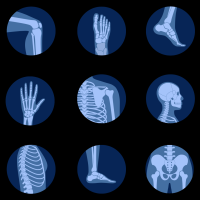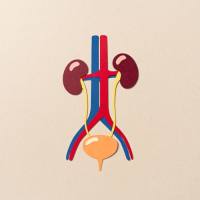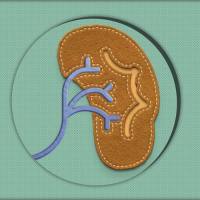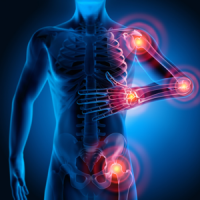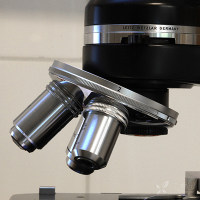【摘要翻译】前列腺癌细胞-成骨细胞相互作用导致前列腺癌细胞生长存活相关基因表达的变化及……
摘要:
研究目的:
前列腺癌特异性的转移至骨骼并导致相应部位的骨骼病变。此前曾有报道将MDA PCa 2b 前列腺癌细胞株与原代鼠成骨细胞(PMOs)在体外混合培养,会导致PMO细胞增生及分化。在给联合免疫缺陷小鼠骨骼内注入MDA PCa 2b细胞后,成骨细胞发生了同样。本次研究的目的:确定在活体和体外试验中导致成骨细胞损害现象的原因;分析多种基因和细胞机制在前列腺癌骨转移的病理生理过程中的意义。
方法及结果:
作者发现在将MDA PCa 2b细胞注入联合免疫缺陷小鼠骨骼的2周后,即可以观察到新生骨形成的组织学证据。在体外试验中,发现PMO细胞也可以导致MDA PCa 2b细胞的增生,这提示两种细胞之间存在着协同性的旁分泌循环。内皮素-1 (多种细胞的促分裂因子),可以在多个前列腺癌细胞株中检测到;Atrasentan,内皮素-1 受体A拮抗剂,可部分抑制MDA PCa 2b细胞诱导的PMO细胞增生。内皮素-1 与多种生长因子共同导致细胞分裂,其中包括胰岛素样生长因子-1 (IGF-1)。在研究中,作者发现在与PMO细胞共同培养的前列腺癌细胞中,其胰岛素样生长因子结合蛋白-3(IGFBP-3)的转录下调(其转录水平受到游离IGF水平调控),同时前列腺特异性抗原(一种已知的分解IGFBP-3的蛋白酶)在150-400ng水平。因此,IGFBP-3在PMO细胞中有抗生长作用,这一点已经在体外试验中得到证明。同时作者的实验显示,在骨转移动物模型中,IGF轴起到了一定作用。其次,在与PMO细胞共同培养的前列腺癌细胞中,其双微粒体(一种P53调节蛋白)的转录水平升高.小鼠双微粒体的P53依赖和非依赖性致癌活动提示了前列腺癌细胞与PMO细胞的共同培养导致了其生存率的提高。最后,作者发现在与MDA PCa 2b前列腺癌细胞共同培养的PMO细胞中,骨保护素的表达下降,而核因子κB配体的受体激动剂上升,这两种现象与成骨细胞活化和骨的吸收有关。
结论:此实验结果为前列腺癌转移的骨骼中骨骼生成和吸收的多种不同的分子机制提供了依据。这些数据也为针对这些分子水平改变的治疗策略提供了理论基础。
Prostate Cancer Cells-Osteoblast Interaction Shifts Expression of Growth/Survival-related Genes in Prostate Cancer and Reduces Expression of Osteoprotegerin in Osteoblasts
Karim fizazi, Jun yang, sara peleg, charles R.silkes, Erica l. Kevin A.Raymond , Todd J. Janus , Christopher J. Logothetis , Gerardd Karsenty , and M. Navone
Departments of Genitourinary Medical Oncology [K.F,J.Y,C.R.S,E.L.K,D.D,M.O,C.J.L,N.M.N] Endocrine Neoplasia and Hormonal Disorders [S.P] and Pathology [K.A.R],The University of Texas M.D. Anderson Cancer center , Huston , Texas 77030; Department of molecular and Human Genetics, Baylor College of medicine ,Houston, Texas 77030[G.K]; and Abbortt Laboratories ,Abbott Park, Illinois[T.j.j]
ABSTRACT
Purpose: Prostate cancer specifically metastasizes to bone where it leads to bone formation. We previously reported that coculturing MDA Pca 2b prostate cancer cells with primary mouse osteoblasts (PMOs) induced PMO proliferation and differentiation . An osteoblastic reaction was also observed in vitro after injection of MDA PCa 2b cells into the bones of severe combined immunodeficient disease mice .The aim of this study was to identify the sequence of events that leads to these osteoblastic lesions in vivo and ,using this in vitro model , to define the contributions of various genes and cellular pathways in the pathophysiology of osteoblastic bone metastases of prostate cancer.
Experimental Design and Results: We show histological evidence of de novo bone formation as 2 weeks after injection of MDA PCa 2b cells in the bone of severe combined immunodeficient disease mice .in vitro ,we show that PMOs induced MDA PCa 2b proliferation ,suggesting a synergistic paracrine loop between those cells and PMOs .Endothelin (ET)-1, which is a mitogen for several all types ,is produced by all prostate cancer cell lines tested , and Atrasentan ,an antagonist of ET-1 receptor A, partially reversed PMO proliferation induced by MDA PCa 2b cells. ET-1 is known to be comitogenic with a number of growth factor, including IGF-binding insulin-like growth factor(IGF)-1. In this study, we report that IGF-binding protein (IGFBP)-3 transcripts (that regulate levels of free IGF) are down-regulated in prostate cancer cells cultured with PMO ,whereas prostate-specific antigen(a protease known to cleave IGFBP-3) is detected in the 150-400 ng/ml range . Accordingly , IGFBP-3 has antiproliferactive effects in PMOS, which were attenuated in our in vitro system . Taken together ,our studies also implicate the IGF axis to play a role in this model of bone metastases . Secondly ,the transcript level of mouse double minute 2 (a protein that regulate p53 ) was increased in prostate cancer cells grown with PMOs. The p53-depended and –independent oncogenic activities of mouse double minute 2 suggest that osteoblasts induce a survival advantage in prostate cancer cells. Lastly , we know that expression of osteoprotegerin is decreased and of receptor activator of nuclear factor-kB ligand is increased inreased in PMOs culture in the presence of MDA PCa 2b cells, two events associated with osteoblast activation and bone resorption.
Conclusions: Our results provide evidence that multiple and distinct molecular events affecting both bone formation and bone resorption concur to the increase bone mass in prostate cancer bone metastases .These data also provide a relation a rationale for developing therapeutic strategies designed to target these molecular changes.






